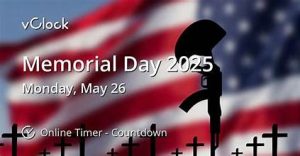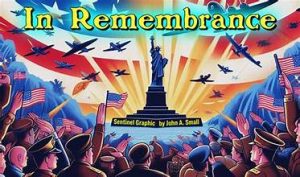Memorial Day From Wikipedia, the free encyclopedia
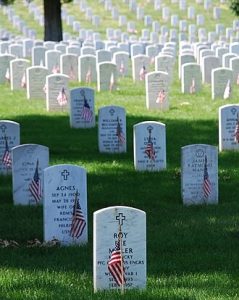 Memorial Day, originally known as Decoration Day, is one of the federal holidays in the United States for honoring and mourning the U.S. military personnel who died while serving in the United States Armed Forces. It is observed on the last Monday of May. Memorial Day is also considered the unofficial beginning of summer in the United States.
Memorial Day, originally known as Decoration Day, is one of the federal holidays in the United States for honoring and mourning the U.S. military personnel who died while serving in the United States Armed Forces. It is observed on the last Monday of May. Memorial Day is also considered the unofficial beginning of summer in the United States.
- Date: May 26, 2025
- Observed by: Americans
- Observances: U.S. military personnel that died in service
- Birthplace: Waterloo, New York
- Declared a national holiday: 1971
Memorial Day for the year 2025 is celebrated/ observed on Monday, May 26th.
It is a day for visiting cemeteries and memorials to mourn the military personnel who died in the line of duty. Volunteers will place American flags on the graves of those military personnel in national cemeteries. Others such as family and friends will also come to lay flowers and grieve on the graves of those who died in the US military.
The first national observance of Memorial Day occurred on May 30, 1868. Then known as Decoration Day and observed on May 30, the holiday was proclaimed by Commander in Chief John A. Logan of the Grand Army of the Republic to honor the Union soldiers who had died in the American Civil War. This national observance followed many local observances which were inaugurated between the end of the Civil War and Logan’s declaration. Many cities and people have claimed to be the first to observe it. However, the National Cemetery Administration, a division of the Department of Veterans Affairs, credits Mary Ann Williams with originating the “idea of strewing the graves of Civil War soldiers—Union and Confederate” with flowers.
Official recognition as a holiday spread among the states, beginning with New York in 1873. By 1890, every Union state had adopted it. The world wars turned it into a day of remembrance for all members of the U.S. military who fought and died in service. In 1968, Congress changed its observance to the last Monday in May, and in 1971 standardized its name as “Memorial Day”.
Two other days celebrate those who have served or are serving in the U.S. military: Armed Forces Day, which is earlier in May, an unofficial U.S. holiday for honoring those currently serving in the armed forces, and Veterans Day on November 11, which honors all those who have served in the United States Armed Forces.
- Memorial Day is a federal holiday observed every year on the last Monday in May. It honors those who died serving in the United States military. In the United States, Memorial Day weekend kicks off the start of the summer season and with Labor Day weekend ending the summer. Most government and businesses offices will be closed on this Day. Armed Forces Day honors those who currentlyserve in the military and Veterans Day honors men and women who have previously served in the United States Military.
National Moment of Remembrance
- On May 3 2000 the United States (signed by then President Bill Clinton) government pushed out the “National Moment of Remembrance” for Americans at 3pm local time on Memorial Day to take several minutes and stop and reflect and have awareness and reverence for those who have died defending our Nation and our values [1][2].
- For many, Memorial Daymeans a cookout, a day at the beach or a surefire three-day weekend. It’s widely considered the unofficial start of summer in the U.S.
- But the federal holiday is a day of remembrance and commemoration for military members who lost their lives in service.
What does Memorial Day represent?
- Many people confuse Memorial Day with Veterans’ Day, but they’re completely different.
- “The holiday was created to honor the many American men and women who died in military service.
- “This focus on those who made the ultimate sacrifice sets it apart from Veterans’ Day, which honors all military veterans, living and dead.”
How did Memorial Day start? History of Memorial Day
- Memorial Day began as a day of commemorating the service of Civil War soldiers and wasn’t originally called “Memorial Day.”
- “Originally called Decoration Day, from the early tradition of decorating graves with flowers, wreaths and flags, Memorial Day is a day for remembrance of those who have died in service to our country,” PBS says.
- “It was first widely observed on May 30, 1868 to commemorate the sacrifices of Civil War soldiers, by proclamation of Gen. John A. Logan of the Grand Army of the Republic, an organization of former Union sailors and soldiers.”
- After World War I, the modern Memorial Day we celebrate today started to take shape.
- “After World War I, it became an occasion for honoring those who died in all of America’s wars and was then more widely established as a national holiday throughout the United States
- “In 1971, Congress passed the Uniform Monday Holiday Act and established that Memorial Day was to be commemorated on the last Monday of May.”
Is Memorial Day a fixed date? How is Memorial Day determined each year?
- No, Memorial Day is not tied to a fixed calendar date. It’s observed every year on the last Monday in May, ensuring a three-day weekend for federal employees.
Is Memorial Day considered the start of summer?
- Yes, many in the U.S. consider Memorial Day to mark the unofficial start of summer.
- Conversely, many see Labor Day weekend, which is also a three-day weekend, as the unofficial close of the summer season in the U.S. Labor Day always falls on the first Monday of September.
Is Memorial Day a federal holiday?
- Yes, Memorial Day is one of 11 permanent federal holidays.
Why Is The Poppy Associated With Memorial Day?
Poppies are associated with those who died during wartime since World War I. In the war-torn battlefields of Europe, the common red field poppy (Papaver rhoeas) was one of the first plants to reappear. Its seeds scattered in the wind and sat dormant in the ground, only germinating when the ground was disturbed—as it was by the very brutal fighting of World War 1.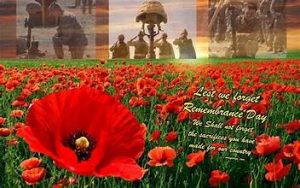
In the US people wear the red poppy on Memorial Day to honor those who died trying to protect the country, according to The Department of Veterans Affairs. In Canada, poppies are worn on Remembrance Day, November 11th.
The red color is not a symbol of blood, death, or support for war. Instead, poppies were the only flowers that grew in war-torn battlefields. When the countrysides were nothing but mud and devastation, poppy flowers sprouted up and flourished. The sight of the red poppies inspired one Canadian soldier, Colonel John McCrae, to pen a poem in May 1915:
In Flanders Fields
In Flanders fields the poppies blow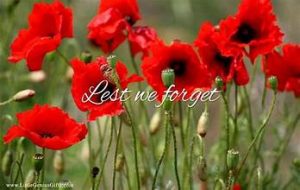
Between the crosses, row on row, That mark our place; and in the sky
The larks, still bravely singing, fly.
Scarce heard amid the guns below.
We are the dead. Short days ago
We lived, felt dawn, saw sunset glow,
Loved, and were loved, and now we lie
In Flanders fields.
Take up our quarrel with the foe:
To you from failing hands we throw
The torch; be yours to hold it high.
If ye break faith with us who die
We shall not sleep, though poppies grow
In Flanders fields.
Colonel John McCrae
The poem moved so many, especially two women—Anna E. Guerin of France and Moina Michael of Georgia. Together they sold artificial poppies to benefit children left orphaned by the War, and by 1922, the poppy was adopted as the official memorial flower of the VFW. The Friday before Memorial Day was designated as Poppy Day.
